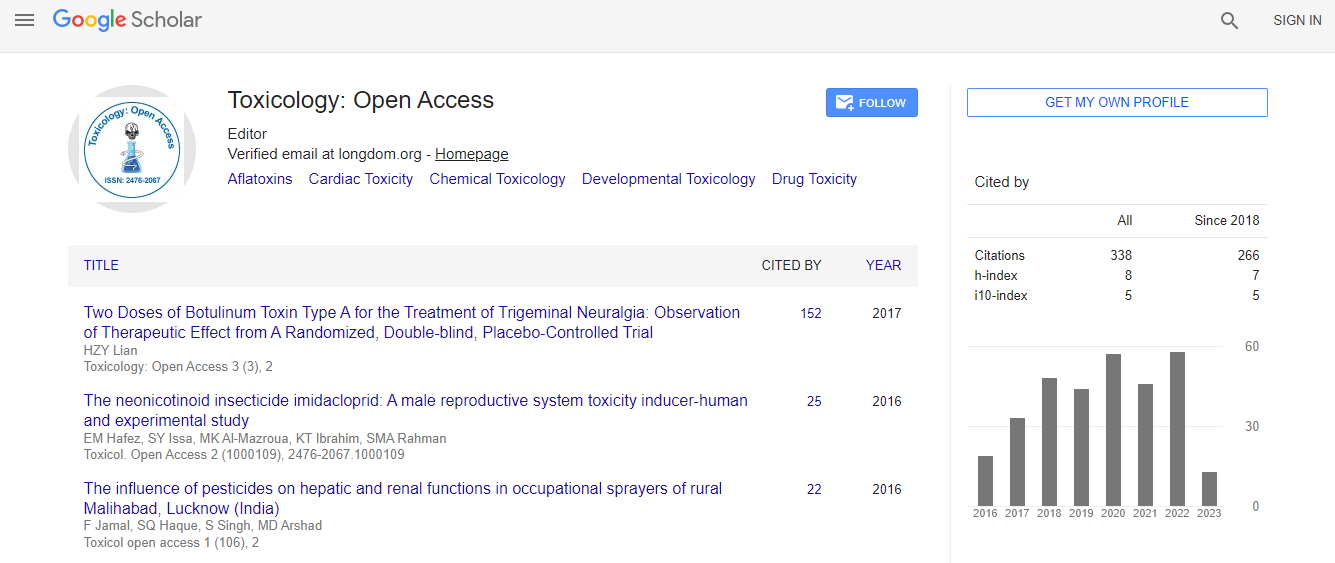Our Group organises 3000+ Global Conferenceseries Events every year across USA, Europe & Asia with support from 1000 more scientific Societies and Publishes 700+ Open Access Journals which contains over 50000 eminent personalities, reputed scientists as editorial board members.
Open Access Journals gaining more Readers and Citations
700 Journals and 15,000,000 Readers Each Journal is getting 25,000+ Readers
Google Scholar citation report
Citations : 336
Toxicology: Open Access received 336 citations as per Google Scholar report
Indexed In
- Google Scholar
- RefSeek
- Hamdard University
- EBSCO A-Z
- Geneva Foundation for Medical Education and Research
- Euro Pub
- ICMJE
Useful Links
Related Subjects
Share This Page
Cytotoxicity of molybdenum trioxide nanoplates
20th World Congress on Toxicology and Pharmacology
Lidia Zapor
Central Institute for Labour Protection, Poland
Keynote: Toxicol Open Access
Abstract
Introduction & Aim: Nanostructured molybdenum trioxide (MoO3-NPs) is promising material in many applications, in coatings, plastics, textiles, pigments, lubricants, ceramics and glass production, as antimicrobial agents and for the detection of Dopamine in pharmaceutical and clinical preparations. In recent years, it was noted that in the case of nanomaterials should carefully evaluate the risks of their use, as they may pose a health risk. The main aim of this study was to assess the cytotoxic activity of MoO3-NPs in human pulmonary cells.Methods: The cytotoxicity of MoO3-NPs was assessed on the alveolar carcinoma epithelial cells (A549) and normal bronchial epithelium cells (BEAS-2B) after short and long-term time of exposure. Cytotoxicity studies included the effect of MoO3-NPs on cell viability, cell membrane integrity (NRU assay), mitochondrial metabolic activity (MTT assay) and the ability of the cells to proliferation (Clonogenic assay).
Results: MoO3-NPs induced a dose- and time-related negative effect on the viability of both kids of the cells in the cytotoxic doses range 50-300 μg/ml, depending on cytotoxicity endpoint. In long-term exposure (7 day), MoO3-NPs at concentrations about 100 μg/ml impaired proliferations, implying their potential chronic toxicity. A549 cells were less sensitive than BEAS-2B one, to all measurement parameters.
Conclusion: The sensitivity of BEAS-2B cells to MoO3-NPs is of particular concern. These cells form a defense line of the body against the penetration of particles into lungs. Inhibition of the ability of BEAS-2B cells to proliferate under the influence of MoO3-NPs may be an unfavorable phenomenon for predicting their long-term effects of exposure.
Biography
Lidia Zapor is currently working in the Department of Chemical, Aerosol and Biological Hazards in the Central Institute for Labour Protection, National Research Institute (CIOP-PIB). She is the Head of Laboratory of Toxicology. The main area of her professional interest is problems of human in the working environment and the toxicity of chemical substances as well as methods of estimating the toxicity of substances in vitro.
E-mail: lizap@ciop.pl

 Spanish
Spanish  Chinese
Chinese  Russian
Russian  German
German  French
French  Japanese
Japanese  Portuguese
Portuguese  Hindi
Hindi 